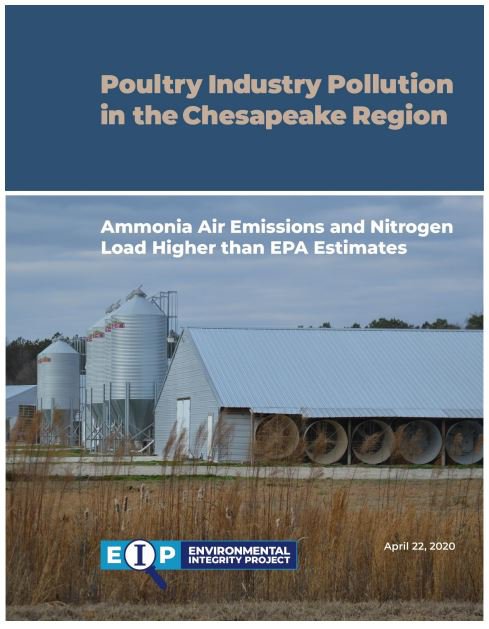On Earth Day, the Environmental Integrity Project (EIP), a CPR ally, released a new report on nitrogen pollution from poultry operations in the Chesapeake Bay watershed. Using data from the Chesapeake Bay Program’s pollution modeling program, EIP found that approximately 24 million pounds of nitrogen pollution from the poultry industry entered the Chesapeake Bay’s tidal waters in 2018. This amount is greater than the total nitrogen from urban and suburban stormwater runoff in Maryland and Virginia combined (20 million pounds in 2018). All that nitrogen pollution can contaminate drinking water sources of nearby communities and feeds huge algal blooms in the Bay that block sunlight, choking off fish and plant life.

Nearly two-thirds of the poultry industry’s nitrogen pollution comes from broiler farms that raise chickens for meat. The Delmarva Peninsula — including Dorchester, Somerset, and Wicomico counties in Maryland (which have 220 registered poultry animal feeding operations, or AFOs) — is one of the greatest contributors of nitrogen pollution to the Bay.
The two major sources of nitrogen from poultry operations are airborne ammonia emissions from chicken litter and manure runoff into waterways (each contributing about half of the total nitrogen load to the Bay). Ammonia is a colorless compound characterized by a pungent odor and is produced as a byproduct of animals digesting food. It is emitted as a gas from poultry houses, then quickly settles onto nearby land or water.
In addition to the ecological harms of excess nitrogen pollution, exposure to ammonia can contribute to poor health in nearby communities. Ammonia is water soluble and when inhaled can quickly dissolve in the upper respiratory tract, irritating the eyes, nose, and throat. Strong ammonia odors from livestock operations are also associated with “odor annoyance” among neighboring residents.
Airborne ammonia can also rapidly react with atmospheric nitrate and sulfate to form PM2.5 (fine particulate matter), a pollutant that contributes to aggravated asthma, decreased lung function and respiratory symptoms, cardiovascular disease, and premature death. Children, the elderly, and people with underlying respiratory conditions are particularly vulnerable to harm from PM2.5 exposure. One 2011 study estimates that PM2.5 formed from ammonia emitted by livestock operations contributes 5 to 11 percent of total PM2.5 concentrations in a given region.
In addition to ammonia, poultry houses emit hydrogen sulfide, various pathogens and endotoxins, and other contaminants. The cumulative burden of these pollutants contributes to various adverse health outcomes. As described in EIP’s report, several studies published in the last five years found an association between community proximity to AFOs and pneumonia, asthma exacerbations, lung disease, stress, and respiratory and gastrointestinal infections.
Residents of Maryland’s Lower Eastern Shore have long sounded the alarm about the impact these facilities have on their communities. For example, EIP’s report features the story of Sam Berley and his wife Patricia, who live in Somerset County with their two children. In 2015, the family farmer next door sold the property to a new owner that built six chicken houses holding 270,000 birds. Sam, who suffers from asthma, told EIP, “The ammonia smell from urine and feces is so strong, and so offensive, it’s hard to breathe sometimes…. There are other chicken houses down the road that are even closer than these. When I drive by, half the time I have to hold my breath until I’ve passed. The odor is just overwhelming.” Air monitoring conducted by EIP in 2016 and 2017 near Berley’s home found ammonia levels averaged more than 20 times higher than what is considered normal for the area.
In an email exchange, now-former Wicomico County resident Margaret Barnes told me her family left the area after a string of health issues arose soon after arriving. "The life of all animals in industrial factory farms is so unnatural, so cruel and so toxic that no one should be shocked when it manifests as pure poison in our air and water," she wrote. "The sickness surrounding this industry is reflected in the number of neighbors with severe respiratory disease, asthma, and cancer. Since we have moved far away from CAFOs, our health has drastically improved. As a mother, I could never subject my child to living near a CAFO or slaughterhouse again." Barnes joined CPR and other community and public health advocates in March to testify in favor of a moratorium on new and expanding CAFOs in Maryland.
Despite these concerns, the number of chicken houses continues to increase on the Delmarva Peninsula. EIP’s report also found that the weight of broilers steadily increased in Delaware and Maryland between 2008-2018, meaning more nitrogen-rich manure is being produced per bird. The Delmarva Poultry Industry (DPI) also continues to deny that air pollution from the operations they represent harms the health of surrounding communities.
Unfortunately, quantifying the public health harms from poultry operations is difficult, as no existing AFO permits require monitoring or control of ammonia or other air emissions. Furthermore, DPI has not updated the public on whether they have installed the air monitoring stations they announced more than a year ago.
In light of these concerns, EIP’s report recommends, among other things, that AFOs be required to install air pollution monitors and report emissions on an annual basis; EPA should establish safety thresholds for ammonia for fenceline communities; and states and EPA should require poultry houses to install effective air pollution control systems.
You can read the full report on EIP's website.
